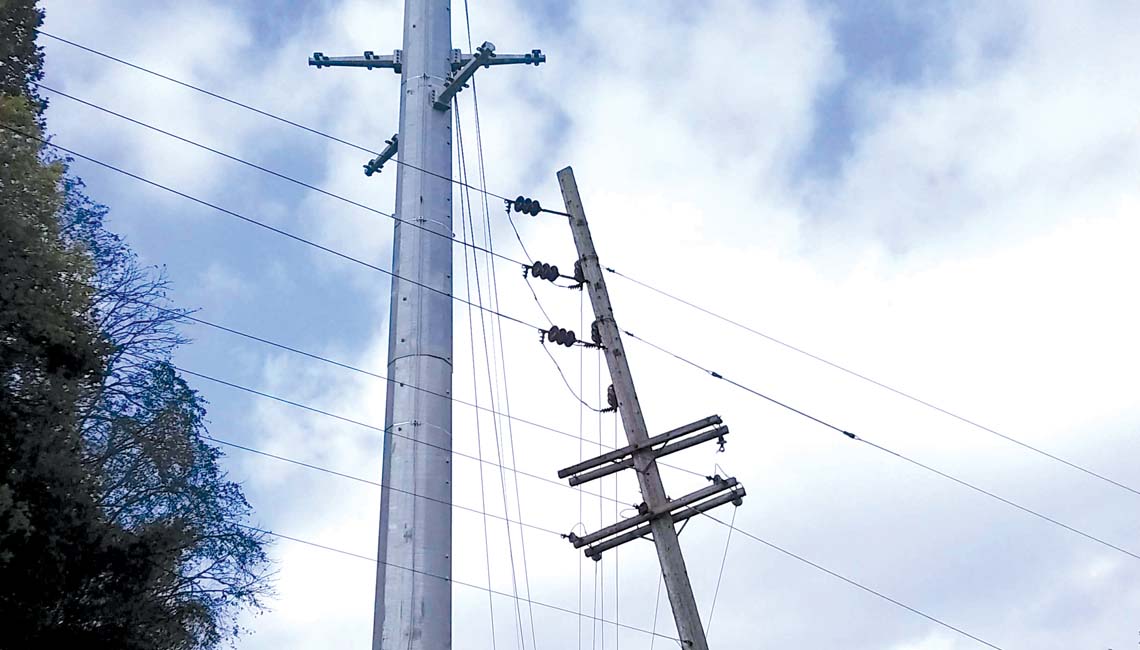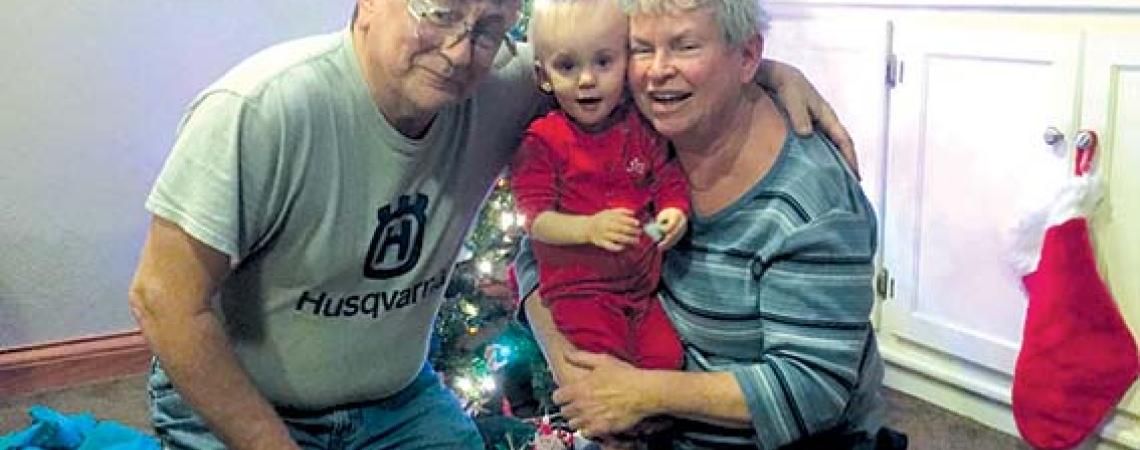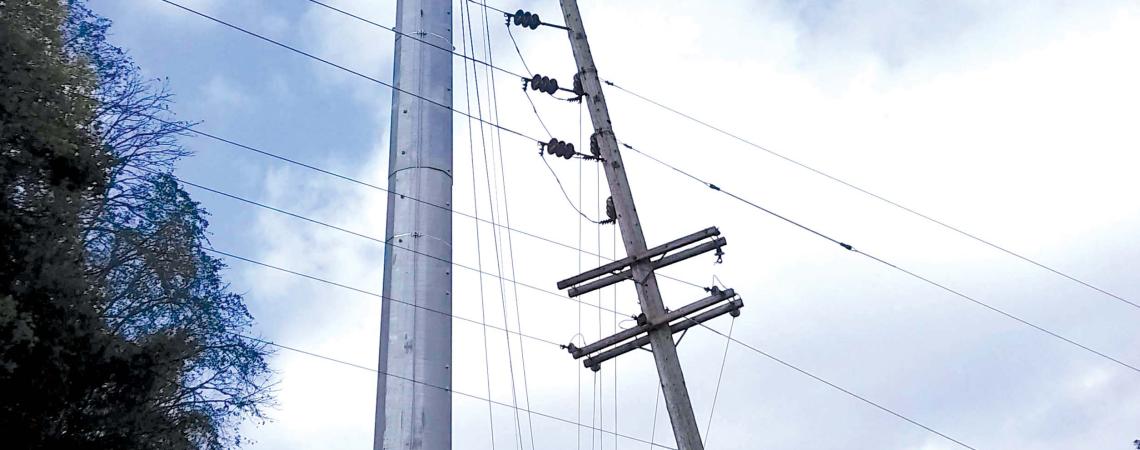Judy Mercer was just sitting down with her family — all 16 of them — for Thanksgiving dinner in 2014 when the lights in their house near Wingett Run suddenly went dark.
Judy and her husband, Larry, and their grown kids and their families — most in the group are members of Marietta-based Washington Electric Cooperative — just rolled with it. They lit some candles and got right on with their meal, and power eventually was restored sometime in the middle of the night. Then, almost exactly a month later, on Christmas Eve, the family had gathered once again for dinner when it happened again. This time, the lights stayed off until well into the next day.
Judy and Larry Mercer posed with their then-new granddaughter, Lily, shortly before their lights went out on Christmas Eve in 2014.
“I’ve lived in the country my whole life, so honestly, I’m used to it,” Judy says. “We were actually thankful because we knew that there were linemen already out working on the problem even by the time we called it in, but that was when we got our generator.”
That area in and around Wayne National Forest in northeastern Washington County had long suffered from the least reliable electric power of any electric cooperative territory in Ohio, and the main reason is that the AEP transmission lines that bring electricity into the area dated back to the very beginning of Washington Electric in 1940.
“So much of the old infrastructure that was put in place right as electrification was first coming to rural areas — you can just imagine those folks saying, ‘This equipment will last for the next 50, 60, 70 years,’” says Tom Schmidt, principal planning engineer for Buckeye Power, the cooperative that generates and delivers the electricity to Ohio’s distribution cooperatives. “Well, that was 80 years ago. Those poles and lines are not only coming of age, but much of the system is also actually well beyond the end of its useful life, and it needs to be replaced.”
Three-legged stool
Most people who think even a little about their electricity probably understand two of the components involved in lighting their homes. Co-op members see the distribution part every day when they look at the lines coming from the poles to their homes. Those who have toured the Cardinal Plant certainly understand generation, or the production of electricity. Ohio cooperatives own their distribution network as well as the generation station.
It’s the third component, transmission, that is least noticed or understood — even though it’s such a significant portion of every electric bill. Other utilities own the transmission lines, and cooperative members pay to use the services from that network.
“Transmission is the way that the electricity gets from the power plant to the local cooperatives’ facilities. The co-op then distributes that power to individual homes and businesses,” Schmidt says. “It’s supplied from outside companies like AEP, FirstEnergy, Dayton Power and Light, and Duke. Buckeye Power and the co-ops are in constant contact with all of those companies to advocate for better reliability and fair rates.”
Well more than half of the outage minutes here are because of transmission issues. Those are the really memorable outages where half the county is dark and power doesn’t come back on for a long time.
“When the power goes out, most folks will think it’s because a squirrel got into a transformer or something like that, within the distribution system,” says Ben Wilson, Buckeye Power’s director of power delivery engineering. “But Ohio electric cooperatives report that well more than half of the outage minutes here are because of transmission issues. Those are the really memorable outages where half the county is dark and power doesn’t come back on for a long time.”
Addressing the need
That was the case for the outages at the Mercer family’s holiday celebrations a few years ago. The substation that delivered power to their part of the county was at the end of an old and failing transmission line that Buckeye Power had been lobbying for years to have upgraded.
“Unfortunately, upgrading is never a simple matter of just running a new line,” Schmidt says. “The poles that carried the line have to be replaced, and the service upgraded and voltage standardized — a lot of technical stuff — along with all the paperwork, acquiring new land or leases, conforming to regulations that had changed completely since those lines first went up. In heavily forested and hilly terrain like that, it’s not unheard of for new transmission upgrades to cost $3 million for every mile of line.”
Federal regulatory agencies have begun recognizing the need for improved transmission and have begun to update rules to make it more attractive for companies to make the kind of significant investments that are needed.
AEP transmission recently completed an 18-mile stretch of new power lines in and around Wayne National Forest, and work is underway for 25 more. Judy Mercer says that since the upgrade, the widespread power outages that used to happen so regularly have become a rarity.
“Buckeye Power uses outage data to influence decisions on where those investments are taking place,” Schmidt says. “We can be a squeaky wheel when we need to be, and we’re able to come in and say, ‘Hey, we know you’re going to be spending a lot of money, so how about spending it in these places where our members are receiving substandard service?’ We’ve been pretty successful getting them to agree.”
Reliability comes at a price
Of course, those upgrades have a price. “Even in the best circumstances, no one ever loves getting an electric bill, but that’s especially so when it keeps going up,” Schmidt says. “Right now, those increases are almost entirely because of transmission upgrades.”
“Transmission increases are universal and have affected all electricity users — not only our members, but customers of AEP, Duke Energy, FirstEnergy, DP&L,” Wilson says. “We work hard to make sure that cooperative members see the benefits of those investments.”
Buckeye Power, from its outset, has been committed to balancing affordability and reliability. The co-ops realize that the transmission improvements have had an impact on their members’ bills, but there’s no question those upgrades are significantly improving reliability. Buckeye Power’s staff will continue to advocate for improvements that benefit electric cooperative members, who often live in areas that need them most.
“Every electric distribution cooperative in the state has its own No. 1 transmission reliability concern, and we try to get in front of everyone’s No. 1,” Wilson says. “In some cases, that means small improvements that go a long way. Some, like Washington’s, are colossal in scope — and there are a couple more like it that are lining up. But there’s always a new No. 1, and as long as transmission companies are spending the money, we’re just going to keep picking them off the list.”












